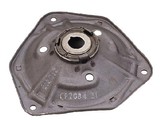I'm ignoring the old original spring-type jobs here for the same reasons I wouldn't suggest using their flywheels! These are the shallow cone-shaped objects that the release bearing pushes on, with a steel band (disc spring) on the underside that presses against the flywheel. This provides the clamping force on the clutch plate that ultimately passes the torque/horsepower to the wheels (via the gearbox of course!) This component is therefore available with various different spring rates/tensions dependent on the application.
I'm not going to bother with actual figures here as it will be meaningless to the vast majority and because they are always referred to by that which they are most recognized - colour. Or to be more precise - the color that is used to identify the different grades. The whole diaphragm is not painted this color, only the spring is color coded by a daub of paint. This is because the actual main body of the diaphragm is the same throughout - apart from the two highest grades where stiffener plates are welded to the release bearing plate retainers.
There are four colors generally now used:
GREEN - the weakest spring as fitted to the small-bore engines (850/998/1098)
BLUE - Fitted to all big-bore engines and all Cooper S’s. This is more than adequate for most road cars, even up to 1380/1400 units putting out 110bhp.
ORANGE - Classed as the Rally/Race type, and the first of the non-standard types. Use on serious road burners developing over 110bhp, and stroker motors producing monster torque over 95lb ft. Advisable to use rally/race clutch plate if this is the case.
GREY - For race use only. Essential when using a sintered/cerametalic clutch plate
DOUBLE GREY - Unbelievably strong for humungous power/torque outputs
There used to be a 'brown' coded one for the 850s - its color code says it all!
Many folk have a nasty habit of over-tightening the diaphragm to pressure plate bolts (and the drive-strap to flywheel bolts come to that.) They should be torqued to a mere 18lb ft - that's all. Also, make sure there are no burrs in the bolt holes left by those who have persisted in doing these bolts up to shear and back a flat. These burrs can cause stress risers in the bolt shanks that lead to breakage. And you certainly don't want that happening!
Useful part numbers:
GCC101 - Standard 'green' coded small-bore diaphragm
GCC103 - Standard 'blue' coded big-bore diaphragm
C-AEG481 - 'Orange' coded diaphragm
C-AEG482 - 'Grey' coded diaphragm
C-AEG483 - 'Double grey' coded diaphragm
2A3657 - Bolt, diaphragm to pressure plate - 3 needed
2A3658 - Drive strap - 6 needed standard, 9 advised for performance use
2A3659 - Bolt, drive strap to flywheel - 3 needed
Let's make sure we're showing you the right parts! Please Select your car type Below:









